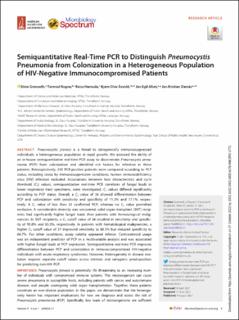| dc.description.abstract | Pneumocystis jirovecii is a threat to iatrogenically immunosuppressed individuals, a heterogeneous population at rapid growth. We assessed the ability of an in-house semiquantitative real-time PCR assay to discriminate Pneumocystis pneumonia (PCP) from colonization and identified risk factors for infection in these patients. Retrospectively, 242 PCR-positive patients were compared according to PCP status, including strata by immunosuppressive conditions, human immunodeficiency virus (HIV) infection excluded. Associations between host characteristics and cycle threshold (CT) values, semiquantitative real-time PCR correlates of fungal loads in lower respiratory tract specimens, were investigated. CT values differed significantly according to PCP status. Overall, a CT value of 36 allowed differentiation between PCP and colonization with sensitivity and specificity of 71.3% and 77.1%, respectively. A CT value of less than 31 confirmed PCP, whereas no CT value permitted exclusion. A considerable diversity was uncovered; solid organ transplant (SOT) recipients had significantly higher fungal loads than patients with hematological malignancies. In SOT recipients, a CT cutoff value of 36 resulted in sensitivity and specificity of 95.0% and 83.3%, respectively. In patients with hematological malignancies, a higher CT cutoff value of 37 improved sensitivity to 88.5% but reduced specificity to 66.7%. For other conditions, assay validity appeared inferior. Corticosteroid usage was an independent predictor of PCP in a multivariable analysis and was associated with higher fungal loads at PCP expression. Semiquantitative real-time PCR improves differentiation between PCP and colonization in immunocompromised HIV-negative individuals with acute respiratory syndromes. However, heterogeneity in disease evolution requires separate cutoff values across intrinsic and iatrogenic predisposition for predicting non-HIV PCP. IMPORTANCE Pneumocystis jirovecii is potentially life threatening to an increasing number of individuals with compromised immune systems. This microorganism can cause severe pneumonia in susceptible hosts, including patients with cancer and autoimmune diseases and people undergoing solid organ transplantation. Together, these patients constitute an ever-diverse population. In this paper, we demonstrate that the heterogeneity herein has important implications for how we diagnose and assess the risk of Pneumocystis pneumonia (PCP). Specifically, low loads of microorganisms are sufficient to cause infection in patients with blood cancer compared to those in solid organ recipients. With this new insight into host versus P. jirovecii biology, clinicians can manage patients at risk of PCP more accurately. As a result, we take a significant step toward offering precision medicine to a vulnerable patient population. One the one hand, these patients have propensity for adverse effects from antimicrobial treatment. On the other hand, this population is susceptible to life-threatening infections, including PCP. | en_US |

